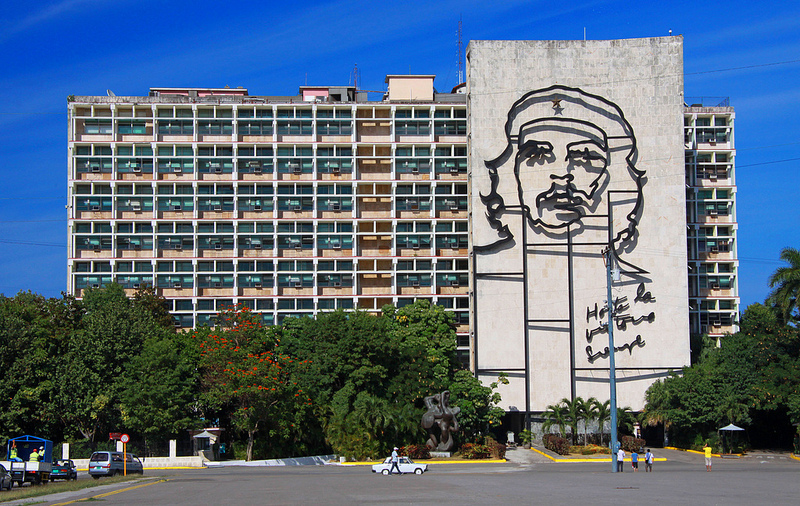
The “mural” of Che Guevara on the Ministerio del Interior building. Photo © Guillaume Baviere, licensed Creative Commons Attribution.
Havana’s largest plaza, Plaza de la Revolución (Revolution Plaza), which occupies the Loma de los Catalanes (Hill of the Catalans), is an ugly tarred square accurately described by P. J. O’Rourke as “a vast open space resembling the Mall in D.C., but dropped into the middle of a massive empty parking lot in a tropical Newark.” The trapezoidal complex spanning 11 acres was laid out during the Batista era, when it was known as the Plaza Cívica. It forms the administrative center for Cuba. All the major edifices date back to the 1950s. Huge rallies are held here on May 1. The plaza is under close surveillance and loitering is discouraged.Among the important buildings are the Biblioteca Nacional (National Library, tel. 07/855-5442, Mon.–Sat. 8:30 a.m.–5:30 p.m.), Cuba’s largest library, built 1955–1957 on the east side of the plaza in a similar monumental style as the Palace of Justice; the 21-story Ministerio de Defensa, originally built as the municipal seat of government on the plaza’s southeast side; and the Teatro Nacional (National Theater, Paseo y Av. Carlos M. de Céspedes, tel. 07/879-6011), one block to the northwest of the plaza, built 1954–1960 with a convex glazed facade. Paseo climbs northwest from the plaza to Zapata, where in the middle of the road rises the Memorial a Ethel y Julius Rosenberg, bearing cement doves and an inset sculpture of the U.S. couple executed in Sing Sing Prison, New York, in 1953 for passing nuclear secrets to the Soviet Union. An inscription reads, “Assassinated June 19, 1953.” The Cuban government holds a memorial service here each June 19.
To the rear of the library is the Monumento El Legado Cultural Hispánico, a larger-than-life bronze statue by American sculptor Anna Hyatt Huntington of two naked men (one on horseback) passing a baton.
One block northeast of the plaza is the Museo de Historia del Deporte (Sports History Museum, Av. Rancho Boyeros, e/ 19 de Mayo and Bruzón, tel. 07/881-4696, Tues.–Sun. 10 a.m.–5 p.m., CUC1), in the Sala Polivatente Ramón Fonst stadium.
To get from Vedado to the plaza, you can take bus #84 from the bottom of La Rampa, at Calle O and Humboldt.
The massive Monumento José Martí on the south side of the square sits atop a 30-meter tall base that is shaped as a five-pointed star. It is made entirely of gray granite and marble and was designed by architect Enrique Luis Varela. Completed in 1958, it predates the Revolution. To each side, arching stairways lead to an 18-meter-tall (59-foot) gray-white marble statue of national hero José Martí sitting in a contemplative pose, like Rodin’s The Thinker.
Behind looms a 109-meter-tall marble edifice stepped like a soaring ziggurat from a scifi movie. It’s the highest point in Havana. The edifice houses the Museo José Martí (tel. 07/859-2351, Mon.–Sat. 9 a.m.–5 p.m., entrance CUC3, cameras CUC5, videos CUC10). Among the exhibits are first-edition works, engravings, drawings, maps, and artifacts relating to Martí’s life. New Age music plays in the background, drawing you to a multiscreen broadcast on the Wars of Independence and the Revolution. An art gallery features portraits of Martí. For an additional CUC2 an elevator whisks you to the top of the tower for a 360-degree view over Havana.
The center of government is the Palacio de la Revolución (Palace of the Revolution, tel. 07/879-6551), immediately south of the José Martí monument. This monumental structure was inspired by the architecture then popular in Fascist Europe and was built 1954–1957 as the Palace of Justice. Today, it is where the Castro brothers and Council of Ministers work out their policies of state. The labyrinthine, ocher colored palace adjoins the buildings of the Central Committee of the Communist Party. Before the Revolution, the buildings served as the Cuban Supreme Court and national police headquarters. No visitors are allowed.
Commanding the northwest side of the plaza is the seven-story Ministerio del Interior (Ministry of the Interior, MININT, in charge of national security), built in 1953 to be the Office of the Comptroller. On its east side is a windowless horizontal block that bears a soaring “mural” of Che Guevara—the image is from Alberto “Korda” Gutiérrez’s world renowned photo—and the words Hasta la Victoria Siempre (“Always Toward Victory”), erected in 1995 from steel railings donated by the French government. See it by day, and by night, when it is illuminated.
In October 2009, a visage of Comandante Camilo Cienfuegos (identical in style to that of Che) was erected on the facade of the Ministry of Communications, on the plaza’s northeast corner. The 100-ton steel mural was raised for the 50th anniversary of Cienfuegos’s death and is accompanied by the words Vas bien, Fidel (“You’re doing fine, Fidel”). Cienfuegos’s famous response was in reply to Fidel’s question “Am I doing all right, Camilo?” at a rally on January 8, 1959. The ground floor Museo Postal Cubano (Cuban Post Museum, Av. Rancho Boyeros, esq. 19 de Mayo, tel. 07/882- 8255, Mon.–Thurs. 8 a.m.–5:30 p.m., Fri. 8 a.m.–5:30 p.m., entrance CUC1) has a well catalogued philatelic collection, including a complete range of Cuban postage stamps dating from 1855, plus stamps from almost 100 other countries. A filatelica sells stamps.
Excerpted from the Fifth Edition of Moon Cuba.